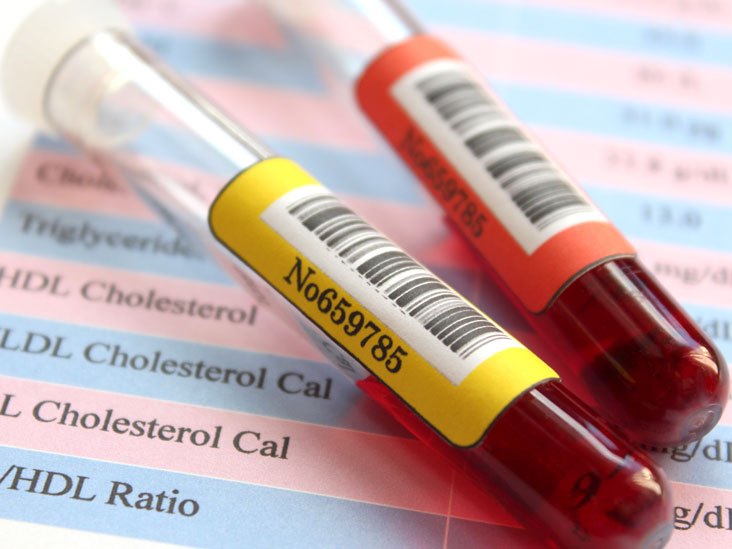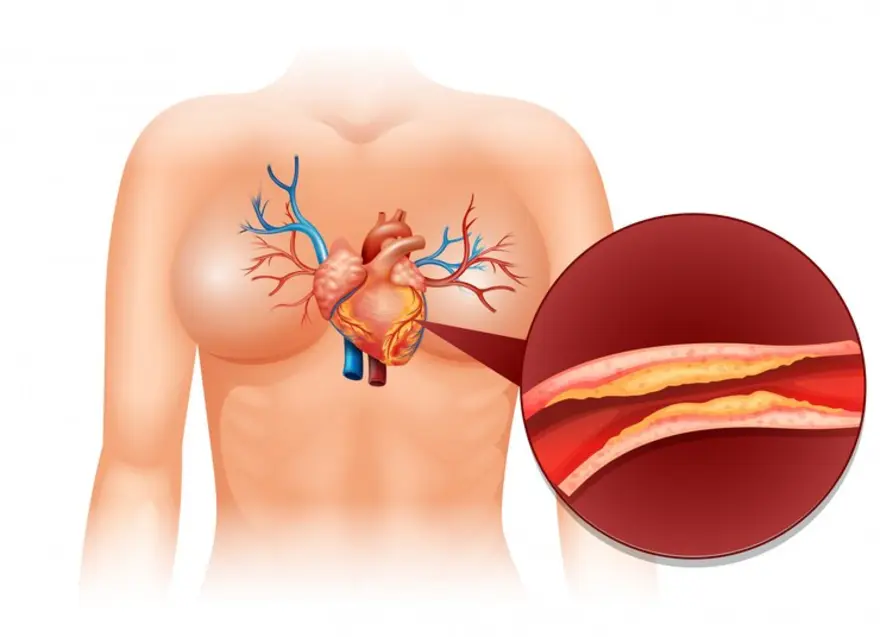Lipid profile test
Lipid Profile Test: Normal Range, What It Is, Purpose, Preparation & Results
Lipids are the fatty acids and their derivatives that are present in our bodies. Not all lipids are bad; in fact, lipids play a pivotal role in the functioning of the body as they are a part of the cell membranes and hormones, provide cushioning, and are a storehouse of energy. High levels of certain kinds of lipids, however, are harmful, especially to cardiovascular health. The lipid profile test measures the different types of lipids in our bodies. Read on to know more about the lipid profile test, its significance, preparation, and results. What is a Lipid Profile Test? A lipid profile test is a blood test that measures different types of lipids in the blood. The lipid profile test is also known by the names of a lipid panel, lipid test, cholesterol test, etc. It measures the levels of four different types of cholesterol and triglycerides. LDL (low-density lipoproteins): LDL is the cholesterol that is considered "bad cholesterol" because it forms plaques in the arteries and adversely affects heart health. Thus, LDL cholesterol should be maintained in the lower range. VLDL (very low-density lipoproteins): VLDL appears in the blood soon after we have consumed food. A lipid profile is done as a fasting test, and thus, if there is an increased level of VLDL in the blood sample, it can be suggestive of some metabolic disease. HDL (high-density lipoproteins): HDL cholesterol is also known as "good cholesterol" because it helps clear away the bad LDL cholesterol and prevents its build-up. Total cholesterol: It is the sum of all the different types of cholesterol in your body, i.e., LDL + VLDL + HDL. Triglycerides: Our body converts the excess calories into triglycerides and stores it as body fat. High levels of triglycerides are harmful to the heart, liver, and pancreas. Why is the Lipid Profile Test Performed? A lipid profile test is performed to find out about your cardiovascular risk factors. Elevated cholesterol levels can indicate that you might be at a higher risk of suffering from heart issues such as atherosclerosis, hypertension, heart attack (myocardial infarction), or stroke. High cholesterol levels do not cause any visible symptoms. Thus, physicians use the lipid profile test to screen and monitor the lipid levels in the blood and detect elevated levels early on before they adversely affect cardiovascular health. The lipid panel is also used as a tool to: Diagnose other conditions such as fatty liver or pancreatitis. Monitor the effectiveness of cholesterol-lowering medications if you are already on treatment for high cholesterol. Monitor the progression of hyperlipidemia if you had abnormal lipid profile tests previously. Who Needs to Have a Lipid Profile Test? You should have a lipid profile test if: You are a male over the age of 45 or a female over the age of 50. You are a smoker. You are obese. You have hypertension or diabetes. You have an immediate family member with a history of heart disease at a young age (below 55 years for males and below 65 years for females). Children can also have high cholesterol levels due to genetics or being overweight. Guidelines suggest that males in the age range of 45–65 years and women in the age range of 55–65 years should have a lipid panel test every 1–2 years and every year after the age of 65. How is a Lipid Profile Test Performed? A lipid profile test is a blood test. To perform this test, a lab technician ties an elastic band on the upper arm and you are asked to make a fist. This ensures greater blood flow into the veins. The skin around the vein on the arm is cleaned to prevent any infection, and the needle is inserted into the vein. Blood is then drawn using a syringe, and the sample collected is sent to the laboratory for analysis. It usually takes 1-2 days for the test results to come. How Much Does the Lipid Profile Test Cost? The lipid profile test price is only Rs. 800 at Metropolis Healthcare, which is a pathology specialist in India. Is There Any Special Preparation Required for the Lipid Profile Test? Yes, fasting of 10–12 hours is required before the lipid profile test. The results are accurate if this test is performed on an empty stomach. Thus, it is generally done in the morning after overnight fasting. Water is allowed during the fasting period, but no tea or coffee. How to Interpret the Results of the Lipid Profile Test? The lipid levels are measured in milligrams per deciliter of blood. The normal values for different types of lipids are as follows: Total Cholesterol: Less than 200 mg/dL. HDL (high-density lipoproteins) cholesterol: More than 60 mg/dL. LDL (low-density lipoproteins) cholesterol: Less than 100 mg/dL; less than 70 mg/dL for people with diabetes. Triglycerides: Less than 150 mg/dL. The values of different lipids determine if you are at a low, borderline, intermediate, or high risk of developing cardiovascular issues. Usually, higher than normal LDL cholesterol, total cholesterol, triglycerides, and low HDL cholesterol levels indicate increased risk. What is the Next Step if You Have an Abnormal Lipid Profile Test? An abnormal lipid profile test, i.e. elevated LDL, total cholesterol, triglycerides, and/or low HDL levels, does not always mean that you require treatment for it. The values considered abnormal depend on several other factors. Your physician will look at your lipid levels and decide if it warrants treatment after taking into consideration your age, family history, medical history, the medications you are on currently, etc. You can bring your lipid levels down by making some healthy lifestyle modifications such as dietary changes, exercising regularly, and losing weight (if overweight). If your physician deems it appropriate, he will prescribe you some cholesterol-lowering medications to help decrease cholesterol levels and reduce the risk of cardiovascular diseases. Your healthcare provider may suggest repeating lipid profile tests at regular intervals for monitoring purposes. Conclusion It can be stressful to receive any abnormal test results. However, abnormal lipid profile results are not always concerning. Your cardiovascular risk is determined by several other factors apart from cholesterol levels. Your physician is the best judge to decide if you need treatment for your lipid levels.
4 Heart Related Blood Tests for Heart Disease: Assess your Heart Health
Are you aware that your heart, the organ which you usually and casually blame for your unwarranted actions, actually doesn't control your emotions? It, in fact, allows pumping of blood, oxygen, and nutrients throughout your body. It beats over 100,000 times per day and pumps about 1.5 gallons of blood every minute. It keeps itself superactive so that you can keep going. But are you taking enough care of your heart health? Heart disease has become one among the emerging health issues in developing India. As per the WHO, more than four out of five heart disease deaths are due to heart attacks and strokes, and one third of these deaths occur prematurely in people below 70 years of age. Don’t let your sedentary lifestyle invite health problems for you. Keep track of your health parameters through our TruHealth Health Package. Keep Abreast of Emerging Heart Issues with Health Tests Smoking, high blood pressure, high cholesterol and diabetes are some of the common risk factors for developing heart conditions. While your doctor is the best guide to help you identify your risk of heart disease, it is important to know that some heart related blood tests hold a lot of importance to diagnose and manage heart conditions. Top Heart Blood Tests List for Diagnosing Heart Disease 1. Lipid profile test: Also called cholesterol test, this test measures the levels of fats in your blood and can point out towards your risk of having a heart attack, stroke or other heart disease. This test typically includes measurements of various other numbers: Total cholesterol: This refers to the amount of cholesterol in your blood. An increased level of total cholesterol increases your risk of heart disease. In general, your total cholesterol should be under 200 milligrams per deciliter (mg/dL) or 5.2 millimoles per liter (mmol/L). High-density lipoprotein (HDL) cholesterol: Also called the "good" cholesterol, it helps keep arteries open and your blood to flow more freely. Low-density lipoprotein (LDL) cholesterol: Also called the "bad" cholesterol, too much LDL cholesterol in your blood can lead to plaque deposition in your blood vessels, and results in reduced blood flow. These plaque build up may rupture and cause major heart and blood vessel problems. Triglycerides: These are another type of fat in the blood, high levels of which can raise your risk of heart disease. Your triglyceride level should be less than 150 mg/dL (1.7 mmol/L). For your reference: Total cholesterol = HDL cholesterol + LDL cholesterol + 20% of Triglycerides level 2. High-sensitivity C-reactive protein test (hs CRP test) C-reactive protein (CRP) is a protein which is produced by your liver as part of your body's response to inflammation that may occur due to an injury or infection. The hs-CRP test can spot lower levels of C-reactive protein (CRP) in your blood. A raised hs-CRP test values indicate a higher risk of heart attack, stroke and cardiovascular disease. This blood test has a great significance in diagnosing heart conditions as it can help determine your risk of heart disease before you have symptoms. An hs-CRP level above 2.0 mg/L is considered to indicate an increased risk of heart disease. However, CRP levels can be temporarily increased by many other situations other than a heart disease, like a viral infection. Hence, some experts may suggest doing the test twice, two weeks apart. Remember, only looking at hs-CRP levels may not be enough to arrive at something definite. Your doctor can ask for other health tests as well, and combine your hs-CRP test and other blood test results with your risk factors to get an overall sense of your heart health. 3. Natriuretic peptides test Brain natriuretic peptide is a protein that your heart and blood vessels make to help your body eliminate fluids, relax blood vessels and excrete sodium into your urine. When your heart gets damaged, levels of BNP entering your blood increases. Different people can have different values for normal BNP levels since it can vary based on the age, gender, and being overweight. Need help to detect, diagnose, and evaluate the severity of congestive heart failure (CHF)? Book a NT-Pro BNP Serum test that measures the levels of BNP or NT-pro BNP in your blood. 4. Troponin (T) Test for Heart Attack Troponin (or cardiac troponin) is a type of protein found in your heart muscles. It isn't normally found in the blood and is released into the blood when heart muscles become damaged. A troponin test looks for the level of troponin in your blood. As more and more heart muscle gets damaged, greater amounts of troponin are released in the blood. Two types of cardiac troponin T (cTnT) and I (cTnI) are used as cardiac profile test to identify heart injury or damage. A high level of troponin in the blood may indicate you are having or recently had a heart attack. Some studies have found that troponin I is more specific and a better cardiac marker than troponin T blood test for heart attack. Remember that one heart blood test alone may not determine your overall risk of heart disease. If you think your lifestyle or family history can put you at risk of developing heart disease at an early age, get in touch with a doctor, book yourself blood test for heart blockage and heart Disease as advised, and improve your lifestyle habits.
Diet Dos and Don'ts If You Have High Cholesterol
High cholesterol is a chronic condition that is extending its claws in India gradually. Recent studies have reported that 25–30% of urban and 15–20% of rural India are affected by high cholesterol.* Cholesterol is a fat-like substance found in all body cells. However, an excess or a disbalance of cholesterol values is a major contributor to compromised heart health, heart disease, and stroke. Want to cut your risk of heart disease? Then, it is mandatory to get tested and keep a track of your cholesterol levels. Cholesterol travels within the body with the help of protein molecules, the combined molecule called lipoprotein (lipo: lipid or fats, in addition to protein). Majorly, cholesterol can be of two types, based on the type of protein that transports it through the bloodstream: Low-density lipoproteins/ LDL cholesterol: Carries cholesterol from the liver into the blood, where it can stick to the blood vessels. As this kind of cholesterol is likely to build up, people often refer to it as “bad” cholesterol. High-density lipoproteins/HDL cholesterol: Carries the cholesterol in the blood back to the liver, where it is broken down. For this reason, HDL cholesterol is called “good” cholesterol. A health goal worth achieving for every individual is to elevate levels of good cholesterol and control the rise in bad cholesterol. Book a lipid profile test and know the values. Role of diet in cholesterol The diet, especially fats, we eat has a significant role in blood cholesterol values. Hence, it is of utmost importance to pay attention not only to what types of food we are consuming but also their quantities entering the body. Let’s learn the most important dietary dos and don’ts to follow if your cholesterol levels are high: Dos Watch the type of fat you consume: The dietary fats can primarily be of three types. Different types of fat impact your cholesterol levels differently: Saturated fats: They instruct the liver to produce more bad cholesterol, hence their intake should be limited. Unsaturated fats: Certain unsaturated fats can facilitate the reabsorption of bad cholesterol through your liver. Hence, it is a healthy type of fat that can help reduce bad cholesterol. Trans fats: These fats are produced by an artificial process called hydrogenation, and they might also harm your good cholesterol levels. Fried and packaged foods often contain trans fats. In addition, refined oil, ghee, etc contain saturated fats. Add more sources of unsaturated fats to your diet. Foods like nuts, dry fruits, and seeds are rich in unsaturated fats. Choose healthful fats to lower bad cholesterol levels while maintaining good cholesterol levels. Please note that a completely fat-free diet can also be harmful because it would impair normal nerve and brain function, and can cause inflammation. Fibers for a healthy heart: Fiber can be of two main forms: soluble and insoluble. Many foods contain both forms. At large, the more natural and unprocessed the food, the higher is its fiber content. While insoluble fiber is pivotal for gut health, soluble fiber binds to cholesterol in the blood and helps remove it through feces. Fiber-rich foods have the added benefit of controlling blood sugar levels as well. Include more peas, broccoli, spinach, carrot, pear, oranges, strawberries in your diet. Eat plenty of vegetables. Note that there is no fiber in meat, milk products, or sugar. Use healthy oils for cooking: Mustard oil is a healthier option as it remains stable at high temperatures usually used in Indian cooking. Olive oil is rich in healthy fats too. But limit its usage in salad and dressings, and avoid using it for cooking Indian recipes. Refined oils usually contain more saturated fats. Consume healthy protein sources: Limit unprocessed red meat. Select lean meat (trimmed of fat, and poultry without skin). Including protein-rich foods like fish, eggs, legumes (such as beans and lentils) in your diet keep you full and helps you avoid munching on unhealthy fatty snacks. Dont's Restrict takeaway foods to once a week: Fast food and readymade processed items such as pastries, bread pakodas, burgers, pizza, chips, etc are usually made of unhealthy cheese and rancid oil. Eating them too frequently can hurt your cholesterol levels drastically. Consult with your doctor about how often you can consume outside food. Limit salt in daily food and snack: Limiting salt won't decrease your cholesterol levels directly, but it can help maintain blood pressure levels and decrease your risk of heart diseases. Both high cholesterol and high salt intake can increase blood pressure, and predispose to heart attacks and strokes. Even if you have not been diagnosed with high blood pressure, you should eat less salt. Along with a healthy diet, make sure to get your cholesterol tested regularly. It is important to track so that you know the measures are taking are working well for you.
Differentiating Good and Bad Cholesterol
Have come across the term “high cholesterol” in several health-related discussions and could never decode what it exactly is? Here we explain what is cholesterol, the difference between good and bad cholesterol, and the basics of cholesterol tests. What is Cholesterol? Cholesterol is a type of fat found in your blood. Every organ in your body including the brain, skin, and other organs needs cholesterol to do their jobs. However, you need a little and not a lot of it!. In the body, cholesterol is produced from your liver. Apart from this naturally synthesized cholesterol, you also can get it from the foods you eat. Meat, fish, eggs, butter, cheese, and milk all have cholesterol in them. Fruits and green vegetables do not have any cholesterol. Too much of anything can be detrimental. Similarly, eating too much fat and cholesterol can impact your body and health negatively. What are the types of cholesterol? Cholesterol in your blood needs to travel through the body, but it can’t do this on its own. So, it combines with proteins to travel through the bloodstream. This cholesterol and protein that travel together are called lipoproteins. Chiefly, there are two types of cholesterol: Low-density lipoprotein (LDL) cholesterol or bad cholesterol: Carries cholesterol from the liver into the blood, where it can stick to the blood vessels. High-density lipoprotein (HDL) cholesterol or good cholesterol: Carries the cholesterol in the blood back to the liver, where it is broken down. Find it difficult to remember which one is good and what is bad? Here's a hack: the HDL is the good cholesterol, so remember it as "healthy" cholesterol — "H" for healthy. The other one is bad cholesterol. What happens if you have too much bad cholesterol? If your body has too much LDL (bad) cholesterol, this can stick and build upon the walls of your blood vessels. This buildup is called “plaque.” As this plaque continues to thicken over time, the inside lumen of the blood vessels get narrowed. These narrower blood vessels pose an obstruction to the blood flow to and from your heart and other organs. And, when blood flow to the heart is obstructed, it can cause chest pain or even a heart attack. So, bad cholesterol and heart disease are directly related. Your body naturally produces all the (bad) cholesterol it needs. However, an unhealthy lifestyle can make your body produce more LDL cholesterol than it needs and causes LDL cholesterol levels to rise in the blood: Factors that lead to an increase in bad cholesterol levels include: Eating unhealthy Sedentary lifestyle Smoking or exposure to tobacco smoke Being overweight or obese When people say high cholesterol, they usually mean high levels of bad cholesterol and/or low levels of good cholesterol. Heredity can play a role too You may inherit genes from the family members such as your mother, father, or even grandparents that cause you to have too much cholesterol. This is called familial hypercholesterolemia (FH). FH is dangerous because it can lead a person to develop premature atherosclerotic heart disease. How to know if you have high cholesterol? A complete cholesterol test — also called a lipid panel or lipid profile — is a simple blood test that can measure the amount of cholesterol (and triglycerides) in your blood. This is an important tool for identifying people at significant risk of developing heart disease, especially coronary artery disease. This test can help determine your risk of the buildup of plaques in your arteries that can cause narrowed or blocked arteries, a condition called atherosclerosis. Who should get a cholesterol test? You might be at the risk of having high cholesterol levels and need to take a cholesterol test if you: Have a family history of high cholesterol or heart attacks Are overweight Have an inactive lifestyle Eat an unhealthy diet Indulge in cigarette smoking Are a man older than 45 or a woman older than 55 Have diabetes As per the clinical guidelines, people with a history of strokes or heart attacks need regular cholesterol testing to track the effectiveness of their medicines When to get tested? If you are an adult having no risk factors for heart disease, take it as a regular health checkup once every four to six years; children, teens, and young adults should be tested once between the ages of 9 and 11 and then again between the ages of 17 and 21. When risk factors for heart disease are present, when prior results showed high-risk levels, and/or when undergoing any type of treatment for high cholesterol levels, testing should be done more frequently and at regular intervals of time. If you are an adult at average risk of developing coronary artery disease, you should have your cholesterol checked every five years, beginning at age 18. How to prevent high cholesterol levels? Making lifestyle changes is the first and foremost step to lower your cholesterol level and reduce the risk of developing heart disease. Make exercise an essential part of your daily routine. Avoid processed and deep-fried food items. If you think you might have high cholesterol, get tested, and consult your doctor to seek treatment on time. Making even modest changes now can help you to prevent high cholesterol levels that can save you from significant medical issues later such as heart attack and stroke.
 Home Visit
Home Visit Upload
Upload


















 WhatsApp
WhatsApp